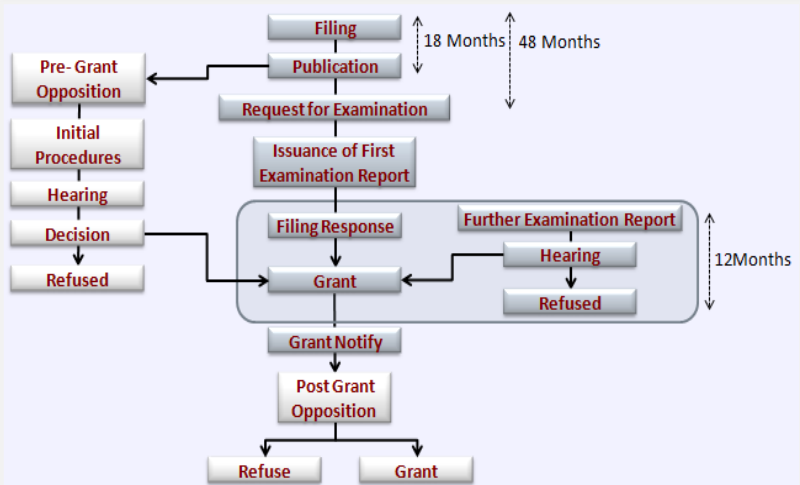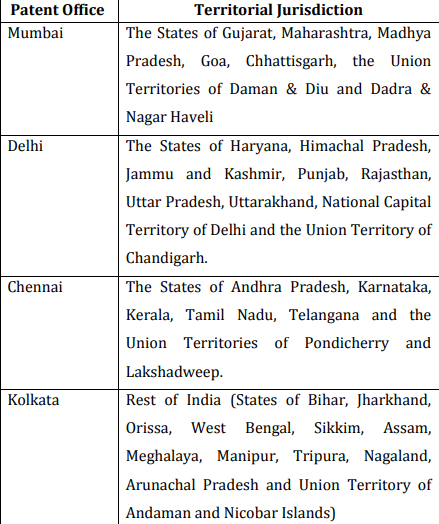The process of Patent prosecution in India starts from filing the application till the very last stage of patent grant or rejection. There is a complete timeline for the legal process with varying duration of different proceedings. The duration of these proceedings are subject to change; this depends majorly on the applicant and on the patent office proceedings.
Here, in this article, we will discuss the complete process of patent prosecution in India along with the time duration associated with each and every proceeding.
Flow chart for Patent Prosecution in India
Here you will find a flowchart depicting complete proceedings through which a patent application goes through. It starts from the stage of patent filing till patent grant or rejection. Furthermore, it incorporates timelines of important events during the prosecution.
Now, we will discuss in detail, the proceedings in the patent office after filing a patent application in India itself.

Filing of Patent Application
The process of patent prosecution commences with filing of patent application. This can take place in the patent office of their respective jurisdictions. The controller of patent office might allocate the application to any of the patent offices, if required. In the image given below you will find the jurisdictions within India having patent offices.

- The office for filing divisional patent application is the same where you filed the main patent application.
- If you proceed with a provisional application, produce the complete application within 12 months for moving further with the process. If you file a PCT application it takes 31 months to become an Indian National Phase Application.
Patent Prosecution in India – The Process
Once the application reaches the patent office, send the fee bearing documents to fee counter and the non-fee bearing ones to non-fee counter.
- The staff makes relevant entries in modules, stamps the documents and generates Cash Book Receipts (CBRs). They enter CBR number, date, mount of fee received, application number, patent number and other related entries.
- The non-fee counter staff also makes relevant entries in document receipt module and stamps the documents so received.
- Forward documents from both the counters to Electronic Data Processing (EDP) section for digitization. And the documents that do not require digitization sent to concerned sections on daily basis.
Initial Processing
On receipt of an application, the office accords a date and serial number to it. Patent applications arranged in e-wrapper.
Screening of application on the basis of:
- International Application.
- Technical field of invention.
- Relevance to defense/atomic energy.
- Correct or complete abstract.
After this they perform numbering of application on the basis of year of filing, jurisdiction and type of application. The application number is a 6-digit common continuous serial number, applicable for all Patent Offices in India.
Scrutiny of Application
There are particular requirements of the patent office according to which a patent application moves in the patent office. You as an applicant should know these scrutiny criteria before filing the application. The scrutiny criteria include:
- Filing in Appropriate Jurisdiction: one of the criteria of scrutiny of patent prosecution in India is the selection of appropriate jurisdiction. If it is not right then they won’t take the application on record and you will receive a notification for the same.
- Proof of Right: file it along with the application, if not file it within 6 months from date of filing of the application. Or otherwise file it with along a petition under rule 137/138.
- Completion and Format of Documents: The office checks whether the application is complete with relevant documents and is in proper format. Along with this, it checks whether it is duly signed by the applicant, inventor(s) or agent (if any).
Publication of Application
From the date of filing or priority date (whichever is earlier) it takes 18 months for publication of the application. Publication takes place in the office journal. You can also make a request for early publication of the application by filling the form-9 with the prescribed fee. In this case the publication takes place within 1 month of the date of request.
Pre-grant Opposition
Pre-grant opposition can take place by a 3rd person after the publication of your patent application. They can question on the patentability criteria which includes- novelty, non-obviousness, non-patentable subject matter, non-disclosure given by the Indian Patent Office.
Examination of the Application
This is the most crucial step in patent prosecution in India or in any jurisdiction. Examination of application commences with a request for examination. This takes place by filling form-18 or form-18A (for startups) along with examination fee (electronic transmission).
- Make the request within 48 months of date of filing or priority date, whichever is earlier.
- If this doesn’t take place, the application is considered as withdrawn.
- No examination takes place without publication and filing of request for examination.
- The patent examiner looks for all the patentability criteria while examining the application. If the application is not in compliance with those criteria, then it will lead to abandonment of the application.
- If there are minor errors like grammatical error, format related errors, then the office controller generates an office action. You need to update the application by correcting the mistakes within a 3 months time period.
- The patent office generates a minimum of 2 office actions, but you can request for continued examination.
- After this if your patent application is in compliance with the patent office rules, you will get the patent grant for a period of 20 years.
- If not then your patent application is prone to rejection.
Annuity Payment
You need to pay an annuity payment to maintain you patent enforceability. It is also known as renewal or maintenance fee. Also, learn to total cost of patent registration in India.
Post Grant Opposition
After 1 year of the patent grant, a 3rd person can file a post-grant opposition. Just like pre-grant opposition he/she can question on the patentability criteria not meeting by the invention. From here the legal proceedings might lead to revocation of patent.
Why Choose Your Patent Team?
Patent Prosecution in India is indeed a lengthy procedure. It endures its peculiar requirements and deadlines. You need to meet those rations and timelines at any cost to receive the patent grant. If at any point, you think of taking professional opinion or service(s), Your Patent Team is at your end.
We cover the whole patent domain from the very first stage till the end. A team of more than 100 patent professionals, we ensure you timely delivery of services, along with quality results. Do give a visit to us at Your Patent Team to learn more.

